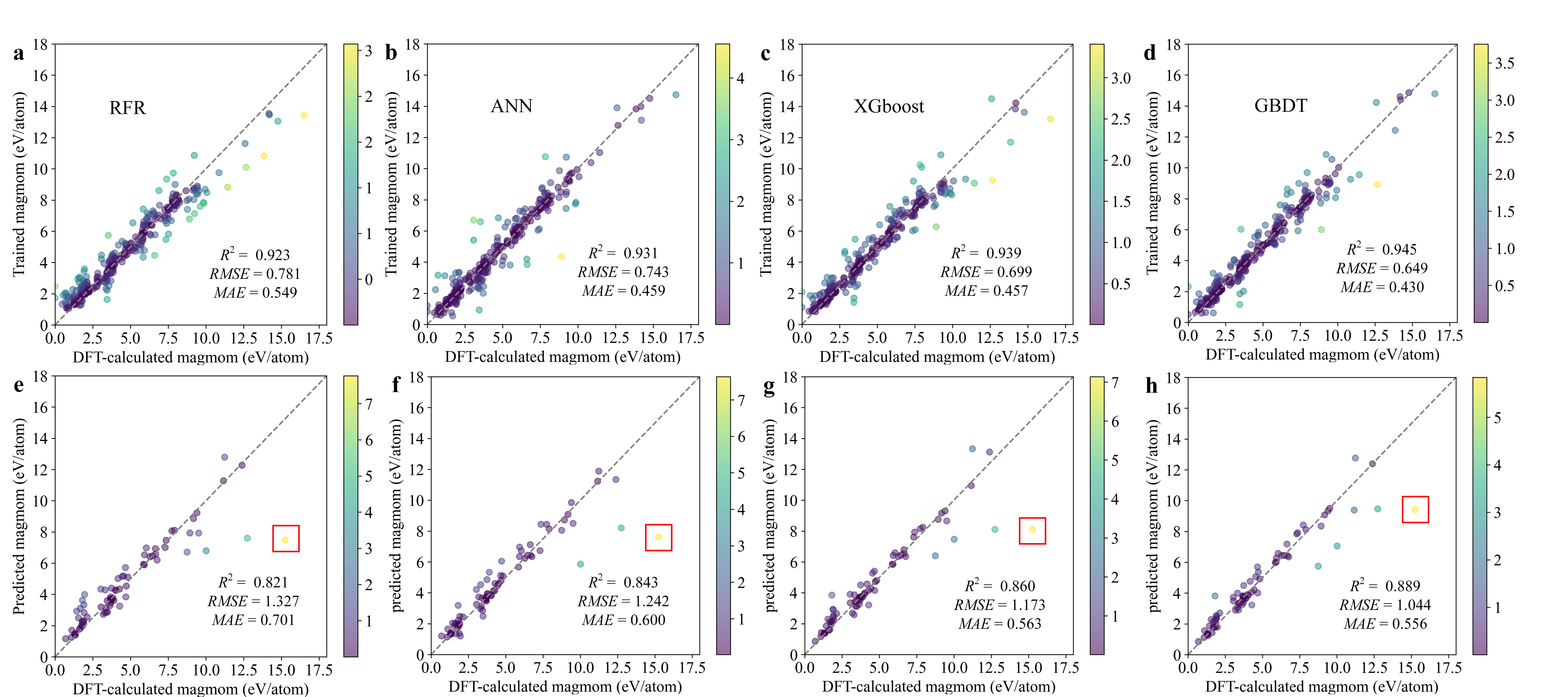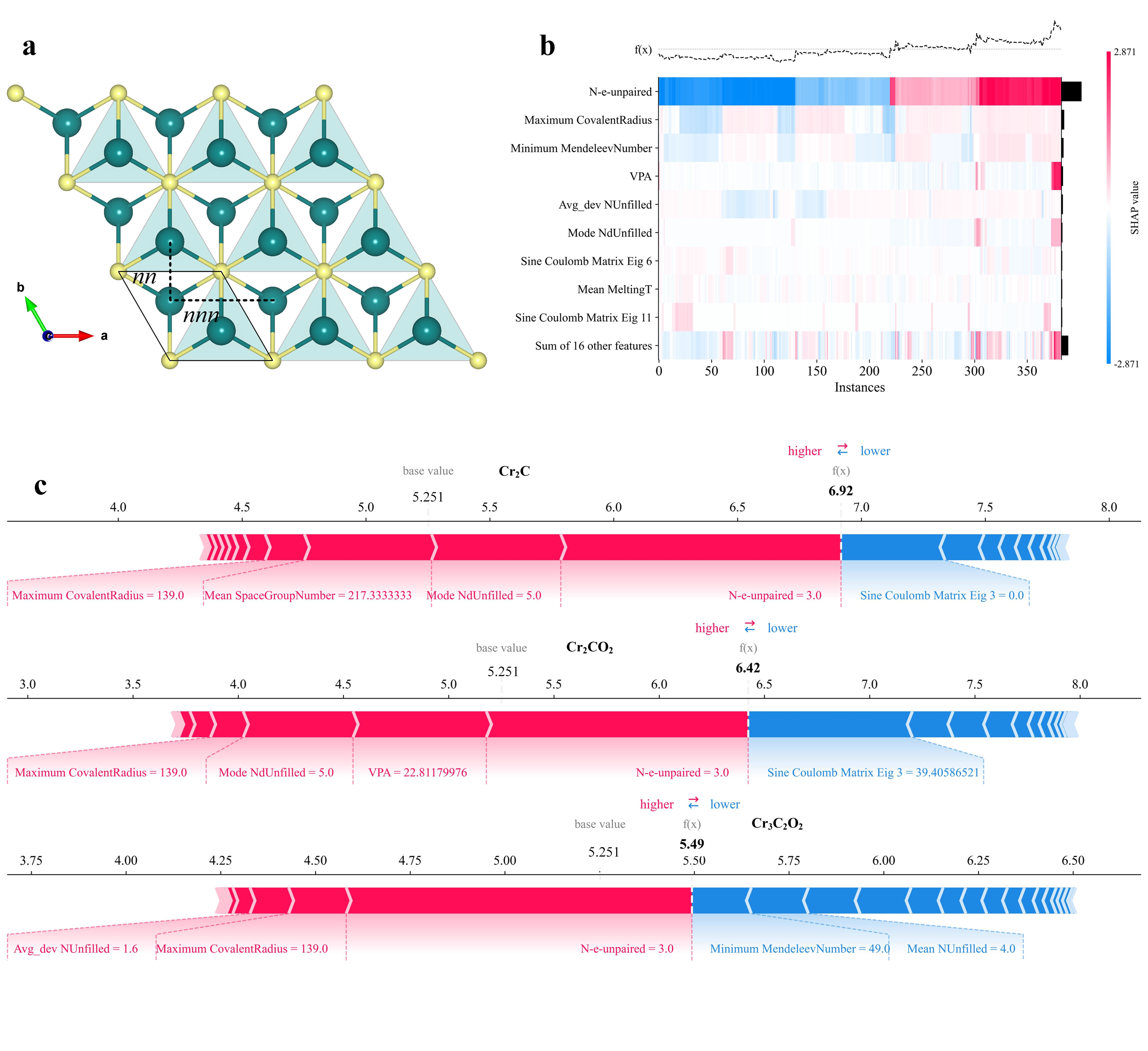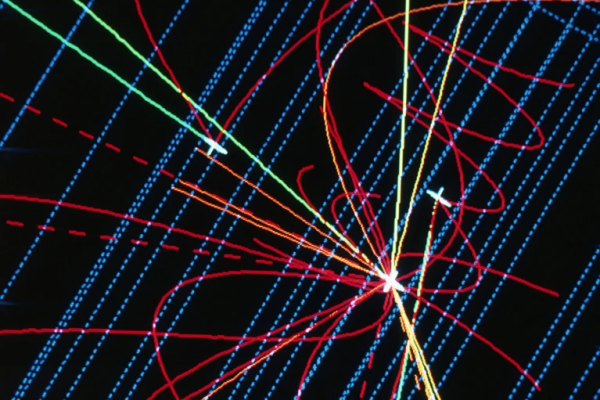Chip发表长春理工大学辛潮团队最新研究成果:机器学习加速发现具有强磁化的新型二维磁性材料
FUTURE远见| 2023-12-22
Future|远见
Future|远见future选编

随着材料数据库的不断完备,以及算力的不断提升,科学研究已经进入大数据驱动的「第四范式」²。人工智能和机器学习算法在新材料的发现中扮演着至关重要的角色。自单层石墨烯被发现以来,二维材料成为凝聚态物理和材料学领域的研究热点。梅尔曼–瓦格纳(Mermin-Wagner)理论指出,在维度d ≤ 2的体系中,由于存在热扰动,不太可能出现满足各向同性的海森堡短程磁相互作用³。然而,近年来在二维单层体系CrI₃, Cr₂Ge₂Te₆中发现的铁磁性打破了这一预言。又重新引发科研人员对二维体系中的磁性的关注热潮。
研究团队提出了一套集高通量计算、模型预训练、磁有序分类和磁矩回归以及密度泛函理论(density functional theory,DFT)计算验证的自适应式体系。基于计算二维材料数据库(Computational 2D Materials Database,C2DB)和二维材料百科全书(2D Materials Encyclopedia,2DMP)等数据库,采用高通量的DFT计算筛选,构建用于预训练的完备二维磁性材料数据集(图1),建立磁性-非磁性,铁磁-反铁磁的分类模型,以及净磁矩的回归模型。通过SHAP值分析模型可解释性。
 图1 | 2D磁性材料的高通量筛选和自适应式机器学习工作流。
图1 | 2D磁性材料的高通量筛选和自适应式机器学习工作流。研究团队通过比对不同机器学习算法:朴素贝叶斯、支持向量机、K紧邻和随机森林、极端梯度提升(eXtreme Gradient Boosting,XGboost)、梯度提升决策树(Gradient Boosting Decision Tree,GBDT)集成算法以及深度人工神经网络(Artificial Neural Network, ANN),优化出设计新材料的最优算法策略。实现对二维材料的磁性-非磁性、铁磁-反铁磁(FM-AFM)的精准分类,分类精度AUC可达0.97(图2)。训练得到能够预测二维材料磁矩的回归模型(图3),测试精度可达R²=0.873。该方案成功将原子位置的平滑重叠(Smooth Overlap of Atomic Positions,SOAP)、正弦库伦矩阵(Sine Coulomb Matrix)以及原子中心对称函数(Atom-Centered Symmetry Function,ACSF)特征编码融合于处理少样本数据集中,弥补了机器学习算法和图神经网络在处理小数据集时的缺陷与不足。通过对数据的深度挖掘和对数据的先验分析⁴⁻⁵,经过蒙特卡洛模拟计算发现二维无机化合物-Cr₂NF₂(MXene-Cr₂NF₂)体系为潜在的多铁性材料。
 图2 | 机器学习FM/AFM分类模型的测试结果。
图2 | 机器学习FM/AFM分类模型的测试结果。 图3 | 二维材料晶胞净磁矩的机器学习回归模型的测试结果。
图3 | 二维材料晶胞净磁矩的机器学习回归模型的测试结果。 图4 | 磁矩回归模型的可解释性SHAP值分析。
图4 | 磁矩回归模型的可解释性SHAP值分析。该研究团队通过对SHAP值详细分析(图4),使训练得到的机器学习模型不再是「黑箱」式的模型⁵,使模型具有可解释性,解决了传统机器学习算法以及神经网络模型在材料预测过程中模型不可解释性的终极难题。并且所得模型成功预测出60种二维材料具备铁磁性,其中13种材料的晶胞净磁矩大于7μB。成功预测出Os₂Cl₈、Fe₃GeSe₂和Mn₄N₃S₂分别为二维铁磁半导体、铁磁金属和铁磁半金属。此外,研究发现,615个候选材料样本在Intel Xeon Gold 5218处理器的集群上进行高通量计算(High-Throughput Calculations,HPC)花费近57600核时。而包括预训练在内的机器学习模型在Intel (R) Xeon (R) Platinum 8259CL上运行约560核时。整个过程中,计算时间减少了一个数量级以上,解决了算力困局,真正意义上实现机器学习算法加速发现二维磁性新材料。
Machine Learning-Accelerated Discovery of Novel 2D Ferromagnetic Materials with Strong Magnetization¹
Two-dimensional ferromagnetic (2DFM) semiconductors (metals, half-metals, and so on) are important materials for next generation nano-electronic and nano-spintronic devices.However, these kinds of materials remain scarce, and “trial and error” experiments and calculations are time-consuming and expensive ¹⁻². In the present work, to obtain optimal 2DFM materials with strong magnetization³, we established a machine learning (ML) framework to search the 2D material space containing over 2417 samples, and identified 615 compounds whose magnetic orders was then determined via high-through-put first-principles calculations(Fig.1-3).
Using ML algorithms, we trained two classification models and a regression model. The interpretability of the regression model was evaluated through Shapley additive explanations (SHAP) analysis⁶(Fig.4). Unexpectedly, we found that Cr₂NF₂ is a potential antiferromagnetic ferroelectric 2D multiferroic material ⁴⁻⁵. More importantly, 60 novel 2DFM candidates were predicted, and among them, 13 candidates have magnetic moments of > 7μB. Os₂Cl₈, Fe₃GeSe₂, and Mn₄N₃S₂ were predicted to be novel 2DFM semiconductors, metals, and half-metals, respectively. This ML approach can accelerate the prediction of 2DFM materials with strong magnetization and reduce the computation time by more than one order of magnitude.
参考文献:
1. Xin, C. et al. Machine learning-accelerated discovery of novel 2D ferromagnetic materials with strong magnetization. Chip 2, 100071 (2023).
2. Agrawal, A & Choudhary, A. Perspective: Materials informatics and big data: Realization of the “fourth paradigm” of science in materials science. APL Mater. 4, 053208 (2016).
3. Mermin, N. D. & Wagner, H. Absence of ferromagnetism or antiferromagnetism in one- or two-dimensional isotropic Heisenberg models. Phys. Rev. Lett. 17, 1133–1136 (1966).
4. Xin, C. et al. Charge disproportionation-induced multiferroics and electric field control of magnetism in a 2D MXene–Mo₂NCl₂. Nanoscale. 15, 14923–14930 (2023).
5. Xin, C. et al. Asymmetric Janus functionalization induced magnetization and switchable out-of-plane polarization in 2D MXene Mo₂CXXʹ. Phys. Chem. Chem. Phys. 25, 8676–8683 (2023).
6. Lundberg, S.M, et al. From local explanat ions to global understanding with explainable AI for trees. Nat. Mach. Intell. 2, 56–67 (2020).
文章链接:
https://www.sciencedirect.com/science/article/pii/S2709472323000345
作者介绍

辛潮,长春理工大学副研究员/硕士生导师。国家材料基因组重大专项核心成员。主要从事二维磁性拓扑材料的计算与图神经网络设计、材料计算方法的发展和开发、半导体物理性质、微纳电子器件的深度学习研究。在二维磁性、多铁性材料以及锂离子正极材料的设计,深度学习算法等研究领域取得了多项重要进展。近年来Nanoscale,Applied Physics Letters,AEM,Nanoenergy等国际权威期刊共发表论文50余篇,文章总引用次数超过1000次 (Google Scholar),h-index 24。
Chao Xin received his Ph.D. degree in 2015 from Harbin Institute of Technology. He obtained a post-doctoral fellow at School of Advanced Materials, Peking University, Shenzhen Graduate School, China (2017). He is currently an associate professor at Changchun University of Science and Technology. His research interests include: high throughput DFT calculation, machine learning, deep learning, Graph neural network, reinforcement learning, energy materials (battery materials, solar energy, multiferroic materials, thermoelectric materials), nanomaterials, nanoelectronics.
关于Chip
Chip(ISSN:2772-2724,CN:31-2189/O4)是全球唯一聚焦芯片类研究的综合性国际期刊,已入选由中国科协、教育部、科技部、中科院等单位联合实施的「中国科技期刊卓越行动计划高起点新刊项目」,为科技部鼓励发表「三类高质量论文」期刊之一。
Chip期刊由上海交通大学出版,联合Elsevier集团全球发行,并与多家国内外知名学术组织展开合作,为学术会议提供高质量交流平台。
Chip秉承创刊理念: All About Chip,聚焦芯片,兼容并包,旨在发表与芯片相关的各科研领域尖端突破性成果,助力未来芯片科技发展。迄今为止,Chip已在其编委会汇集了来自14个国家的70名世界知名专家学者,其中包括多名中外院士及IEEE、ACM、Optica等知名国际学会终身会士(Fellow)。
Chip第二卷第四期将于2023年12月在爱思维尔Chip官网以金色开放获取形式(Gold Open Access)发布,欢迎访问阅读本期最新文章。
爱思唯尔Chip官网:
https://www.sciencedirect.com/journal/chip




